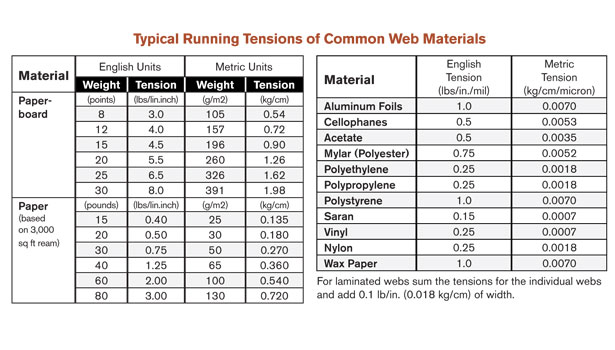Industry Q&A: Tension Control
Maintaining and Servicing Your Tension Control Equipment
We picked Mark Breen’s brain for some insight into how to properly care for tension control equipment. Breen is the marketing manager at Dover Flexo Electronics.




















Q: What maintenance/servicing (type, frequency) should a system get so that tension control remains at peak performance?
A: Since most tension measurement and control components have few moving parts, a well-functioning tension control system should work invisibly for years or decades with minimal maintenance.
We recommend that electronic components, such as controllers, indicators or amplifiers be wiped down periodically with a damp cloth if they’re exposed to factory dust and grime.
Because tension transducers, which are the devices that sense the web tension, are separate components from the electronic devices that they connect to, an electronic device will need to have its meter readout calibrated upon initial installation. This ensures an accurate tension readout from an indicator or tension controller. While regular recalibration of tension electronic components is usually unnecessary, we recommend that maintenance staff verify the calibration during annual machine maintenance to ensure the readout is holding steady.
This series of images shows the calibration procedure for one of DFE’s tension controllers.
Q: Explain what a tension transducer/load cell does, and the role it plays in tension control.
A: Whether one refers to it as a tension transducer or a load cell, this device simply produces an output voltage proportional to tension when an internal mechanical beam is minutely deflected from the force of an idler roll and the web material running across it. The mechanical beam has tiny thread-like strain gauges bonded to it – either foil or some semi-conductor material like Silicon – and the gauges output a small electrical signal when mechanical stress is applied.
Within the world of tension control for the converting and flex-pack industries, tension transducers are designed in a myriad of shapes, configurations and sizes.
Shown here is a dead-shaft idler roll with built in tension transducers at each end to accurately sense tension. This unit would mount with bolts between opposite sides of a machine frame in a location where tension needs to be read or controlled.
When the tension transducer is connect via electrical cable to an electronic device, such as a tension amplifier, indicator or controller and then calibrated, the machine operator can see exactly what the tension is on the web at that location on the machine.
Q: If a company is looking to improve its system with a new tension controller, what is the checklist to look for in the new system?
A: A key to achieving the right web tension for a flexible packaging converting process is the production team’s understanding of their web materials’ physical characteristics, thickness, weight, extensibility and optimum running tensions. For instance, polyethylene runs best at a much lower tension than polystyrene or aluminum foil.
Assuming that management will choose a tension control technology that employs direct tension sensing to achieve the most consistent and accurate running tensions, other key considerations for correcting tension-related web quality problems on a machine are:
- In which tension zones are problems being experienced? Unwind, Intermediate, or Rewind?
- What idler roll locations in the web path are best suited to have tension transducers (load cells) installed on them?
- What are the project budget constraints?
- What tension range will we be running in most of the time? This is important for transducer sizing.
- How versatile do we need the tension control system to be with respect to the range of substrates and material properties the machine will be running?
- Which tension measurement and control vendor will best fill our needs?
- What style of transducer mounting hardware will fit best into this location on the machine frame?
- Should we connect the installed tension transducers to a tension readout device only, or to a closed-loop automatic tension controller?
Ultimately, the production team will want to select tension transducers that will be accurate over the range of tensions the machine will be running. And they’ll select the best tension controller for the applications they’ll be running within their budget. Fortunately, some tension control equipment suppliers offer a range of controllers with varying feature sets and price points to meet customer needs.
Q: What kind of ROI is a company looking at for a new tension controller?
A: The answer to ROI with respect to a new tension control system is that it depends on the cost of the web material being run on the machine and on how many feet of wasted finished material are eliminated by the addition of a tension control system. For high value flexible packaging films, the ROI may be as short as a few days. For lower margin products like plastic bags or kraft paper, ROI may take several months.
Q: Will they need to replace any other equipment or machinery along with the tension controller?
A: The production team may need to replace the tension transducers on a machine when adding a new tension controller if the voltage output from the existing transducers is incompatible with the input requirements of the new tension controller. This problem can occur when using tension transducers from one manufacturer and tension measurement or control electronics from another manufacturer.
Q: How does one determine the target tension measurement for the substrate running? Is that something they must determine, or do you help with that?
A: While determining the best tension for a running substrate used to come down to trial and error, and may still for exotic web substrates, there has been some good data collected by organizations like TAPPI for the target running tensions of the more standard substrates. See chart below. This is also an issue that the experienced applications engineers at the tension equipment manufacturers can assist with.
Dover Flexo Electronics (DFE)
Looking for a reprint of this article?
From high-res PDFs to custom plaques, order your copy today!
















